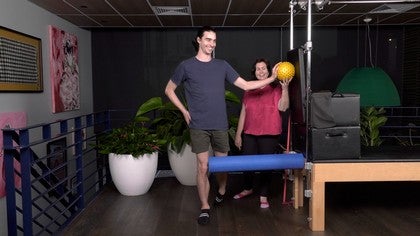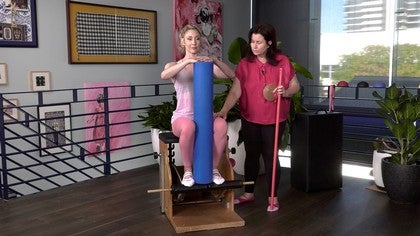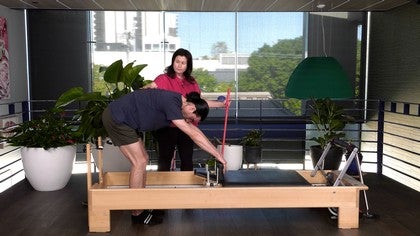Description
About This Video
Transcript
Read Full Transcript
(upbeat music) Today we're going to do some work around the shoulder. And what I love is, I have every prop I could find, for us to work with, okay? This is a wall and I'm just using a made up wall, but I'm sure you'll have a wall at home to work with. The purpose of this exercise, is to help with increasing or maintaining range of motion for the shoulder. Often I find clients have tendinopathies, all sorts of problems that affect their shoulder, that end up with frozen shoulder.
We all hate it. And it's one of the most challenging issues in a studio, and very painful to deal with. It predominantly affects women, it does affect men as well. So understanding that there's no real cure for frozen shoulder, but as someone who has had two of them, aren't I lucky? These are the ones and the exercises that have worked, and helped me regain range of motion, especially on my second one.
I learned my lessons and I applied this, for the second shoulder when it started to freeze up, and as a result, I felt like I avoided the complete catastrophe. So, all of the props that I have, I have my pink glitter broom stick, you don't need a pink glitter one, you can just use a standard broom stick. I have, this is a little makarlu, but you can use a spikey ball, or something kind of soft will, just to you is under your arm. A foam roller. A ball around this size.
I like the coronavirus ball that we have here, because it just helps with group. And some sort of wall, okay? We may use a stool if you want for some exercises, but let's work with this first and see how you go, and then I'll tell you when you use the stool or the little chair for certain exercises. Now, Josh is going to help us, as a lovely model for this exercise. So the first thing that we're going to do, is just do a little test to check your range of motion.
So Josh, you can take the stick, please. And I'm going to get you to put your hands at either side of the stick. Now, what you'll find generally with somebody with a frozen shoulder, it's the abduction range or the internal rotation range that is a problem. So, what we're going to do is use this stick, Josh you're going to hold the stick and you're using the bottom hand to push the stick up and down. And if somebody has a very restricted shoulder, you'll feel this is a little bit harder to do, okay?
So don't try and go to end of range, just allow the yourself or the person you're working with, just take it as far as you can. Nice work Josh, how does that feel? Good. Let's change hands. So you can either put your hand at the end or underneath as a grip.
So, pushing along, lifting up. This side is a little bit more restricted, isn't it? It's just a little bit it crankier as it goes up. Now, what I like to do, is give this to clients as homework, but it's also a really nice exercise as a test exercise throughout your class, okay? Because sometimes you give yourself something or you give a client something, and you really wanna make sure it hasn't made things worse, okay?
Now, so Josh give me the stick and we're going to come up to our lovely wall, okay? We're going to take our foam roller, and Josh, you are going to stand with your back against the foam roller, okay? And all I'm going to get you to do Josh, is just have your feet forward just a little bit, and you're going to take your hands behind you, okay? Pressing that into your wall. If you can, when you are doing this, take your hands up, into little fingertips, like you're holding a large glass, make the arches of your hands work.
Just a nice stretch for the pec muscles. Now, what we're going to do, is press your fingertips into there and hinge forward. Okay, good. And back. Getting that nice hip disassociation, as well as opening out through the pec.
Now, for some people, this is going to be too much. They cannot put their arms this far back. If that's the case, just allow them to have their hands there or put maybe a ball or a yoga block, so that you can press into the wall, so you're not putting yourself into such extreme range. Nice work Josh. And two more.
And back down. Lovely. I'm going to get you to step away from the wall now, and we'll just let the foam roller go there. Yes. Now I'm just going to take this.
Now all I've done here is just make the little dome pressure point. If you have a small ball, that's okay. I don't want it to be too spiky, okay? So what we're going to do Josh is, come here please. I'm going to put this in and I'm just going to put that in and it's going to press under the pec muscle, okay?
So it's attaching just there, and we're going to bend the elbow, okay. You need bigger pecs. Yeah? Okay, and just take your arms back and forward. So kind of like this because we're just triggering in, through some of the important rotator cuff muscles and helping you to get a little bit of a release of some of the muscles that are pulling on your shoulder.
Now Josh, what we're going to do is take your arm out and now you're going to, take the hand back, up and in. Is that okay? Now, back, out and in. One of the reasons why we are doing this sort of work, is we're encouraging Josh to get mobility in his forearm, because often when your shoulder's not functioning, you don't have appropriate stability in your shoulder, you have a tendency to over grip and overuse your forearm. So you see a loss of forearm tightness and restrictions, okay?
Nice Josh. Let me take that away from you. Take your arm down. Okay, let's just do the stick exercise, as a test in between, just to see how it feels on this side. Oh, nicer already.
So you don't have to do this all the time, but I think when you're working with something like frozen shoulders, it's nice to try something and double test it. You can do this on the other side. Now, one of the things about working with frozen shoulders or anything that might be related to a tendinopathy, it's important to work on range of motion, but also to make sure that you are adding in load. So at the moment, Josh is working without any load, he's just using gravity and that can be just enough. What I like to do, is start to add load very gradually.
So I use something like this, which is just a piece of wooden base from the makarlu. But if you don't have something like this, use a saucer, okay? Or a small plate, if you don't understand what a saucer is. So basically what you are doing is, using this to help dome your hand and strengthen the arches of your hand. If you hold a weight, you are gripping and you are generally working in your forearm.
Is that okay Josh? And you can slowly add weight and load to this, but this is enough for now. Thank you, Josh. Thank you, Carla. May I have that please?
Of course you can, Carla. Thank you. Okay. Nice, how's that feel? Nice.
Well next, what we're going to do is, we've done some release, we've tried to help place the shoulder in a happier spot. Now we're going to add a variety of loads and challenge for the shoulder strengthening worker. So you can use a long foam roller or a smaller foam roller, depending on the client. The smaller foam roller would probably be more appropriate at an early stage of this exercise series, because it's less to hold up. You okay with the roller?
Yeah. Yeah. Okay. So, what we're going to do is, Josh, I'm going to get you to put the foam roller there and you're going to put your hand, just your hand, and you're going to press that in. Now, what you're going to do Josh is, press your hand into there and lift this leg up.
And down. So at first, you might just press your hand into the foam roller. So let's just do that, press in and get that isometric activation of the shoulder joint. 10 to 20 seconds would be lovely. Now, Josh took the opposite leg up and that is fine.
I also like to challenge people by taking the same side up. So marching, bringing this leg up. It helps activate the glute. And often you'll find between the shoulder and the opposite hip, could be a real problem. It's this nice little sling activation.
If you want to make this a little bit more challenging, then use even more props. This is lovely, when you have the wunda chair in front and you can just put your foot on the pedal going up and down. Really challenging on the glute, and nice to actually your core working. How's that feel Josh? Yes.
I'm going to take that off you now. Lovely, turn and show to the camera. You can see how already his shoulder is starting to sit in a nicer position. I can feel it, yeah. So let's do the other side.
So remember, pressing your hand into the foam roller, sort of getting that little work into the base of the scaffold there into the foam roller, holding it for about 10 to 20 seconds, and then you're going to lift this leg up. Do your little marching. Now again, this can be kind of challenging for your clients. So be here, standing beside them. What I like too is, even though this is a class about your shoulder, this is a really nice piece of work to do in a balance class, okay?
Because you've got a lovely close chain, you're adding little bit of gate work. If you are wanting to add the balance focus, what you could do is do all sorts of things. You can close the eyes, you can move the head from side to side, all of those fun little things that can just help but to make your life that more challenging. Josh, do you wanna take this whole leg up in the air now or is that just a bit too much? Lovely.
Up and down. So you can see we're adding balance just in this as well, okay? And just one more, working that glute, helping you get nice and strong in that way. Thank you, Josh, take your hand down. Its nice.
Good. Let's just do our little test exercise again. You can skip this if you don't want to, but again, just one each way. Oh lovely. Nice and good.
Its a lot freer. Yes, and a range of motion is what we're looking for, at early stages of frozen shoulders. But we also have to make sure that as soon as we free the shoulder up, we need to get it strong as well, so that we are not constantly injuring. Now the next part. So we've done push in, we're going to do some work on your triceps.
I might get you the smaller foam roller, Josh, just to make this, but you can easily work the larger foam roller. Josh, what I'm going to do, is get you to put your back and we're going to put this, just at your tricep. Okay. So what I've done is, I'm placing the foam roller here, at the base of Josh's arm, just around the tricep point here. And Josh is going to push his arm back, just that little bit, and then he's going to again, straighten the arm out and bit back.
So we're going to keep it quite small start with, okay? We're going to keep it kind of close to the shoulder. And the reason why we're wanting the tricep to work, is remember, the tricep attaches to the lower part of your glenohumeral socket, the official term is inferiorly. So when the tricep's activated, it helps pull your shoulder into the right spot, to help facilitate the subacromial space, okay? How's that feel Josh?
Now again, you can add the load and all of that sort of work. Josh, what I'm going to get you to do next, is we're going to take this just that little bit lower and you're going to step forward, going to put your hand on the foam roller and the elbows bend. Now, this could be the step too far for many clients, because we're really requiring a lot of internal rotation. So they may not be ready for this, okay? If they're not ready for that, take them back, right back, so that their arm..
Yeah, so it's just a little bit gentler, but the idea is, let's move yourself forward here, Josh, if we can. You're going to come into a lunge position, and you're going to press your hands back, bending the knee forward, pressing the elbow back. Nice. And back and forward. It's strong, isn't it?
You can feel that muscle contraction. Now, remember, this is a lot stronger than it looks. If you are doing this in the class with me, you can see how hard this is already. So remember, if it's too much, Josh come back, you might even start the person right back there, let's go back, and even just put that there and even lower maybe, and just press the arm back. A bit easier?
You can still feel that though, yeah. Yeah, and that's what we want, modify appropriately, but still retain your purpose for your exercise. So Josh, we're just going to do the same thing. Yeah, nice. Turn to the camera and actually show, you cannot see how the shoulders are changing, hopefully you can feel that in your own body.
I can. Yeah. And you're the most important person here. So let's just do this. Okay.
Elbow in, so let's push back. Yep. Press back and let's just straighten and bend, okay? You can bring yourself into the little lunge movement as well, if you like. Okay.
Nice. Okay. I would say with a client, five is probably where you need to be. 10 would be great. And again, this is the sort of work that they can do at home as homework, okay?
Then Josh, we're going to take this down, just that little bit lower, put your hand there. Again, remember appropriate, how much shoulder extension can you manage or your client manage? Nice work. Lovely. Let me take that away.
While I'm getting your next prop, just pink sticker for us. Nice. Feeling that already? Definitely. Good.
So, what we all want to remember is, when we're working with our clients, we may need to give them a little bit of a break or you a little bit of a break for your shoulder. So we're going to give you a challenge, to help stabilize in the glute again, very important for the hip and the shoulder connection, but also to give your shoulder a bit of a chance to relax. So Josh, back to the foam roller. What you're going to do is come put your knee, Which way? This way?
Facing that way, facing sideways, the other knee, the inside of that knee, in here. Its a long foam roller and what you're going to do, first one is so you're going to use that, to help stabilize and just activate into the knee. Then you are going to just do a little bend of the knee, maybe take the back leg back further, okay? Just in and out, okay? Really nice way to help activate the glute, and there, good.
Let's just do five to six. If you want to make it a little bit more fun, remember fun was canceled in 2019, but we are going to bring it back, okay? So you're going to take this leg over. Yeah, good. If you need the pink stick for support, hold on.
You all right? Okay. Take your legs over and back. Really nice way to get hip mobility, balance, glute strength. Now obviously somebody with shoulder problems, may have issues holding their arms up like Josh is doing right now.
What we might do, is because we can, bring in more props. Put the ball, hold it onto the wall and press into there, help activate through that shoulder, and then again, do a couple of more, I call this exercise, jumping the lego, that is, you walking around the house, you step on your son's lego. Careful. Up. Nice, good work Josh.
How's that feeling? Good in the glute. Lovely. So what you're going to do is keep that foot back down, just work that glute a little bit more, hold that ball and bring that arm across and over, okay? And back and over.
Now this may be too hard for your clients or for yourself, if that's the case, bring the ball down lower. Get the idea of just transferring the ball from side to side and working on that range, in a kind of fun way. Nice. Lovely. Let me take that off you.
Come off there. Let's do the other side. Okay. You're not me. Okay, so again, foam roller into your knee.
We're just going to do five little lunges and remembering those cues, feel the heel slides back to your sit bones. The focus is on trying to get hamstring activated. You don't want to just bend the knee forward. It's like you are dragging that heel back and you'll get that lovely hamstring activation. Nice work, Josh.
Good work. Okay. Then bending, The lego? You can do your lego. Is that what we're doing?
Yeah, jumping the lego. Oops! So, if I'm working with a client in the studio, I might get them to do about 20 of this, but we may do 10. Do the ball variations, just keeping the leg down. So Josh, you can just put your hands on the wall. They might then just have the leg rest, just do the ball movement, without the lego moving, and then come back and do the lego work again, okay?
So, sometimes you have to on the fatigue factors. So, stop, have a little feel of where your shoulders at. Take the stick, do your little test, see where you're at even. It feels good. It feels yeah, I can see Josh's range, and hopefully your range is feeling a little bit better.
Remember though, you're not to push it, give yourself a break. So this is what I'm saying is, don't just constantly force in the shoulder work, add in the glute work, you're going to help the shoulder just as much. So Josh, what I'm going to get you to do now, is just a wall ball roll, so let's just put your hand there. So to some clients or for yourself, you might find this is all you're at, okay? So we're going to soften the elbow, and I want you to press your hand into the ball, roll the ball up and down.
Nice work. Roll up. Now you might find that you need to roll into the pinky finger just that little bit more, okay? Roll into the pinky finger and down. I know that sometimes I've seen clients being given, they just the walk, the wall, the hand up the wall series.
I kind of like using the ball a little bit more, because it just helps you get that movement. Good work Josh. Okay, now from there, just press the hand in. And if you can, put your hands around the ball, with the activation of the arches of your hand and feel like you can take that ball down towards your hip. Lovely.
Take that ball back up to the wall and then down. So we're adding a little bit of load, but we're actively working the hands and working your shoulder in that nice sense of swing. Good. Just one more. Lovely.
Let's change the side. It's small, but it's strong. Yeah. It's good. It's what we want.
So, press your hands in and up and then take your hands down. Remember, frozen shoulders affect many people, but there are some people who are more likely to end up with frozen shoulders. It is a very common complication, post-breast cancer, because of all the surgeries and damage to the shoulder girdle, and it's very common for people with autoimmune conditions. So when you remember someone like with hashimoto's, their muscle response and muscle strength is delayed, therefore resulting in a greater load on the tendons and their tendon reflexes are also delayed. So, they're likely to get those lovely little microtears, that contribute to the shoulder problems.
So simple things, yes, they'll be seeing their physical therapist for their work, but it's important for them to be able to keep moving and keeping themselves a little bit sane in their Pilates class, okay? Nice, Josh. Just two more. A lot of fun, good. Let me take the ball.
Now we've done some work again, doing some pushing work. We'll do a little bit more of this push activation, so that Josh can, once again, isometrically stabilize the shoulder. So Josh, I'm just going to get you to stand here, put your hand on the foam roller and stand in the middle here, okay. This is another really nice exercise, to do in conjunction with the wunda chair. So I like to do this standing beside the wunda chair, and you can just press your foot in the pedal, but this is also a really nice sort of session, which is lifting the leg up and down, activating the glute, that you can do in the studio, but it's also something you can teach in a Zoom class to your clients, if they can't come into the studio.
Nice work, feel that? Okay. Good. Up and down. He's been a bit of the show off now, but that's okay.
Take that down. Other side. Pressing there. So you can see, activating right back here, into those important rotator cuff muscles, activating into your stabilizing glute. Is that the same leg you just lifted?
No, good. Lovely. I'm taking that down. Josh is feeling good. Okay, hopefully you are too.
Now at the beginning, we had the foam roller behind the back, and you can do that again here if you like. What I'm going to get Josh to do though, is to have his back against the foam, up against our wall, and your hands are going to be on the foam roller, and maybe bring your feet further forward, just a little bit, yeah. Nice. So, we're just going to press our hands into the foam roller just to get your sense of lift and connection. Hinging forward again, and you're just getting the back working.
And can you feel that lovely sense of how the foam roller, helps you just push your shoulder forward into that nice flexion position? Nice work, Josh. Is that okay? Good. And back.
So we're just going to do maybe four or five of this. I really like to make sure we incorporate back strengthening work, as well as shoulder range work here. Now Josh, this time, what you're going to do, is to come back and you're going to have one arm behind you onto the wall. Remember, if you can't put your hand behind you like that, put the ball behind you, put the block behind you, so that you can at least get a little bit of shoulder extension. And this time Josh, you're just going to hinge forward and push the foam roller across in the diagonal, okay?
So we're going to try and encourage, a little bit crossing of the midline of the arm. Now this can be really painful for some clients, so don't push it too far, okay? Is that all right? Final one. Let's change sides.
Hands there. Just put your hand on it. Push your hand in, and move across and around. What I find it's really helpful, for when you do this sort of exercise, is also to remember to move your legs a little bit. So as you twist one, this leg will come out just a little bit and this leg will come in a little bit, we call that the Sache.
And I just want that to help you get that mobility, in your sacrum and your spine. Nice work, Josh. Okay, come up to standing. Shoulders done. Let's just do your final test and see how you feel.
I hope you are feeling as mobile in the shoulders as Josh is. And remember, you might not have to do this whole class, maybe do little bits and pieces, over the course of a week. See what works, add a bit more in. Remember the principles, range then load. Grade your loaded work in slowly.
Don't just go from half a kilo, or half a pound to a pound or a kilo of work. It takes a long time to build the strength. And if you go too fast, you will go backwards in the sort of work hit we are doing here. So slow and steady, wins the race. Thank you and enjoy.
The Teacher's Corner - Playlist 22: Claiming Immunity
Comments
You need to be a subscriber to post a comment.
Please Log In or Create an Account to start your free trial.



















